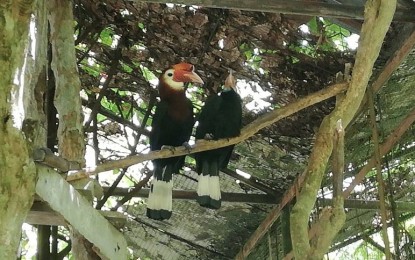
HELP FOR MARI-IT. A pair of Visayan writhed hornbill, considered as the world’s second most critically endangered hornbill, among the 16 hornbills that can be found inside the Mari-it Wildlife and Conservation Park. The park is Panay Island’s first conservation, breeding, and rescue park situated inside the compound of the West Visayas State University-College of Agriculture is being re-introduced as an eco-tourism site hoping it could generate funds to sustain operations. (PNA photo by Perla G. Lena)
ILOILO CITY -- Fourteen years after the Mari-it Wildlife and Conservation Park in Lambunao, Iloilo town announced the successful breeding in captivity of three Visayan writhed hornbill, the park management continues to hope that it can replicate the feat if not this coming breeding season in September, then in the nearest future.
Mari-it (enchanted) is the first conservation, breeding, and rescue park in Panay Island. It is situated in a 1,000-hectare lot within the 3,000-hectare campus of the West Visayas State University-College of Agriculture and Forestry (WVSU-CAF) in Barangay Jayubo, some 16 kilometers away from the town of Lambunao, Iloilo.
It currently hosts 16 Visayan writhed hornbill, considered as the world’s second most critically endangered hornbill and endangered Visayan tarictic hornbill; 20 endangered Visayan spotted deer; 11 critically endangered Visayan warty pigs; five vulnerable Visayan leopard cats and two cloud rats, among others.
Dr. JB Ian Bull, WVSU-CAF veterinarian, said the conservation park used to have funding support from conservationist groups abroad but was eventually cut off when the person-in-charge of preparing their proposals died.
“This is the only park that takes care of endemic animals. It serves as rescue and breeding center,” he said.
With limited funding, they could no longer provide the standard food requirement that is necessary for the hornbill to breed. The standard meal is supposed to be rich in carotene, Vitamin C and carbohydrates; live supply of mice, crickets and worms. Their food must contain three types of fruits per meal. If they have no live food, then they will not breed.
Dr. Bullo added that hornbill aborts their eggs if they know that they could not feed them.
Interestingly, hornbills are loyal to their partners. Female hornbill lays eggs in the trunk of a tree. Once she lays her eggs, she seals the trunk with mud and saliva and stays inside for about two months or until the eggs are hatched. She relies on the male hornbill to provide her with food.
He disclosed that one female hornbill has already died inside the tree trunk due to lack of food.
“The advantage of this center is its environment. Birds are supposed to be at the mid-elevation. This area is in mid-elevation. It is almost ideal,” he shared.
Comes September they will isolate the area where the hornbill is situated because it is their breeding season. He hoped that there will be philanthropists’ kind enough to extend support.
Meantime, the latest addition to the rescued species inside the park was the two leopard cats named “Ponte” and “Vedra” believed to have come from Pontevedra, Capiz.
Bullo said they still have to wait for the assessment of the Department of the Environment and Natural Resources whether or not they are ready to be reintroduced to the wild.
“The Visayan leopard cats are usually hunted to be bred with domestic cats to produce Bengal cat,” he explained. He added that there have been attempts to domesticate them but it usually fails.
On the other hand, Lambunao Mayor Reynor Gonzales said that the local government unit has a joint venture with the WVSU-CAF for the development of Mari-it as an eco-tourism site.
“The joint venture is in existence for the last seven years but the development of the eco-tourism is gradual. We provide funds yearly for small improvements, which in the long run will bring about the further development of the area,” he said.
Under the joint venture, the LGU takes care of the physical development while the university provides for the area and the park itself.
However, he admitted that the fund they allocate is not enough. There are a lot of improvements that are being proposed. The development is continuous; they have to provide space where tourists can stay, ensure peace and security and come up with cultural shows to encourage them to stay.
“We are promoting Mariit as an eco-tourism site so that on its own it will be self-sustaining. In the meantime, the LGU is the one providing funds,” he said.
Aside from the said species, the park has two springs and rich flora and fauna. “We balance the development in relation to the ecosystem, we provide the place for animals conducive to recover,” he said.
He emphasized that the park is significant not only for Lambunao but for the whole province of Iloilo. The park provides space for the endangered species “where they can settle and in time when they will be released back in the wild,” he said.
However, until such time that the people learn to appreciate them and understand the need to protect the mountains where the species thrive, then they could not tell when is the right time to release them back into the wild.
Otherwise, the mayor said that in the future, they might just see them only in pictures.
“This is a conservation park for endangered species. We are breeding hornbills in captivity. We also accept animal species classified as endangered and we protect them there,” he stated. (PNA)
